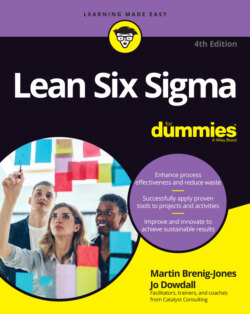Читать книгу Lean Six Sigma For Dummies - Martin Brenig-Jones - Страница 50
Taking a Pragmatic Approach
ОглавлениеSix Sigma and DMAIC have been criticized by some for being too complex, and for projects taking too long. Be pragmatic. Projects need to take as long as is appropriate and often only a few simple tools and techniques are needed to secure quick and successful improvements.
Some say that “pure” Lean doesn’t always ensure a systematic and controlled approach to achieving and holding on to improvement gains. This is where the Control phase of DMAIC is so important. For relatively straightforward problems, rapid improvement events can be used, and they can be run in one-week sessions. The implementation of the improvement may take a further month or so, and some pre-event planning and data collection is necessary.
These events bring together the powerful concepts of Continuous Improvement, or Kaizen, to involve people in continuously seeking to improve performance within the framework of DMAIC. That improvement comes from focusing on how the work gets done and how well. Kaizen is the Japanese word for Continuous Improvement, where “Kai” means “change” and “zen” means “good.” Put together, Kaizen means “change for the better.”
Rapid improvement events can also be run as a series of half or one-day workshops, over a period of five or six weeks, or less. They follow the DMAIC framework, and particular emphasis is placed on the Define and Control phases. So, for example, the first workshop focuses on getting a clear definition of the problem to be tackled (Define), and so on. The aim is to tackle a closely scoped bite-sized problem using the expertise of the people actually involved in that process to solve it. They’ll need someone with Lean Six Sigma experience as a facilitator, because they may need help using some of the tools and techniques required (for example, Value Stream Maps — see Chapter 5). So often, the people doing the job know what’s needed to put things right. You may well find that the solution is already known by the team, but historically they haven’t been listened to. Implementation of the solution can thus be actioned quickly, much of it during the actual event. Rapid improvement events can provide the people doing the job with the opportunity to use their skills and knowledge.
In terms of time, the short duration of rapid improvement events compares to perhaps four months part time in a traditional DMAIC project, though the actual team hours may be similar.
